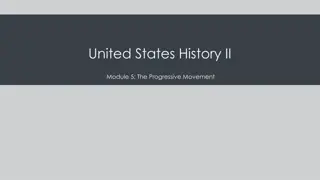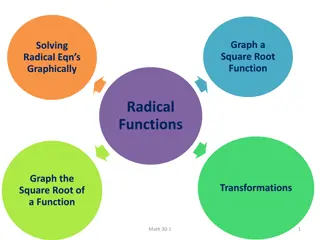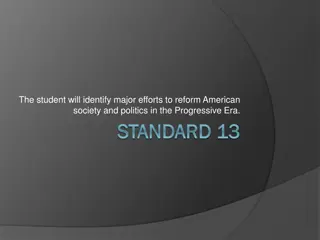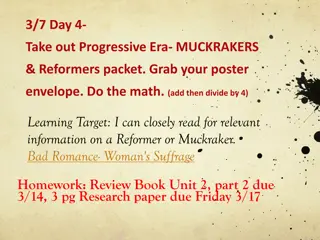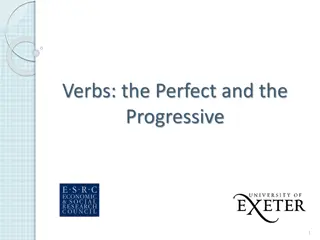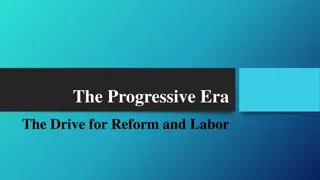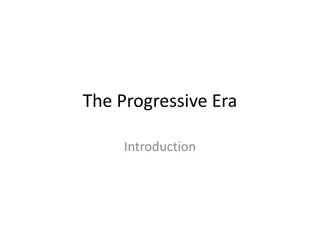The Radical Center: Jane Addams and the Progressive Movement
This chapter explores the life journey of Jane Addams and her role during the Progressive Era. It reflects on how societal changes, women's independence, and collective struggles shaped the middle class, challenging traditional norms. The chapter discusses the emergence of the progressive movement driven by social welfare reforms, women's rights, and a shift towards community well-being.
Download Presentation

Please find below an Image/Link to download the presentation.
The content on the website is provided AS IS for your information and personal use only. It may not be sold, licensed, or shared on other websites without obtaining consent from the author.If you encounter any issues during the download, it is possible that the publisher has removed the file from their server.
You are allowed to download the files provided on this website for personal or commercial use, subject to the condition that they are used lawfully. All files are the property of their respective owners.
The content on the website is provided AS IS for your information and personal use only. It may not be sold, licensed, or shared on other websites without obtaining consent from the author.
E N D
Presentation Transcript
THE RADICAL CENTER Michael McGerr
This chapter follows the life journey of Jane Addams and others like her during the time of industrialization, her establishment of the Hull House for social welfare, and her experience and those of others on how the progressive movement was conceived. The following slides contain summarizing quotes from the chapter:
"In some ways, the Progressive Era emerged from a middle class that could not cope with its own affluence." "Generations of Victorians had built successfully on the bedrock values of domesticity, hard work, self-restraint, and individualism." Due to increase access to higher education and advancements in technology, women were finding a lot less satisfaction with doing traditional "women's work" in the home and were increasingly becoming more independent and satisfied in their own finances and careers. "By the end of the nineteenth century, the middle class had drafted - but had only begun to ratify, a kind of tacit peace treaty between the sexes. Forced mainly by the individual and collective struggles of Victorian women, this rough agreement included three principle provisions: eliminating the double standard (that husbands can go find sexual pleasure elsewhere in the nighttime, while women cannot), easing women's domestic burden, and increasing their public opportunities."
"In the late nineteenth century, middle-class women and men crusaded against alcohol, pornography, prostitution , and gambling. Thus 'purity crusade' intended to create a world less enticing to men, less likely to seduce them from home." "Voluntary womanhood (the notion that women should have the right to dictate when to have sexual intercourse and children) was part of the broader effort to lighten the weight of domesticity for women." "Although home economics generally supported wives' and mothers' continuing role as homemakers, the movement hardly intended to confine women to the house. Instead, the pioneering home economists wanted to make it easier for them to venture out" and become more involved in public affairs." Victorians, such as Jane Addams, eventually started to study and address the issue of clashes between the classes. They also began to denounce individualism. "By the turn of the century and the approach of Queen Victoria's passing, the American Victorians were no longer Victorians. Rethinking domesticity, rejecting individualism, reconsidering wok and pleasure, and redesigning the body, middle-class men and women had cast off much of their old identity. Strengthening themselves they were becoming new people."
"Edmund J. James expressed the increasingly common wisdom. 'Government,' he said, 'should interfere in all instances where its inferences will tell for better health, better education, better morals, [and] greater comfort of the community." "There was as well a contradiction between the justifications for two key progressive goals - curbing the autonomy of the wealthy and improving the status of women. In response to the rich, the progressives condemned individualism. But individualism was central to middle-class women's rebellion against domesticity." "More than any other major group in American society, the progressives had a clear and aggressive agenda by the end of the 1890s Since there were many ways to accomplish these ends, progressives could pursue their particular reforms without stepping on one another." Henry Demarest Lloyd prophesied "the middle class is not to be exterminated, but is to absorb the other classes", perfectly capturing the progressive's mission.


